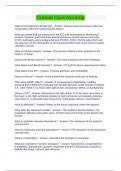Critical Care Nursing
What is Hemodynamic Monitoring? - Answer- Measurement of pressure, flow and
oxygenation within the cardiovascular system.
What are values that are measured in the ICU with Hemodynamic Monitoring? -
Answer- Systemic and Pulmonary arterial pressures, central venous pressures
(CVP), pulmonary artery wedge pressure (PAWP), CO/CI, SV/SV index (SVI) and
O2 saturation of the hemoglobin of arterial blood (SaO2) and mixed venous oxygen
saturation (SvO2).
What is Cardiac Output? - Answer- The volume of blood in liters pumped by the
heart in 1 minute.
What is the Stroke Volume? - Answer- The volume ejected with each heartbeat.
What determines Blood Pressure? - Answer- CO and the forces opposing blood flow.
What determines SV? - Answer- Preload, afterload, and contractility.
What is Preload? - Answer- Volume within the ventricle at the end of diastole.
What does PAWP reflect? - Answer- A measurement of pulmonary capillary
pressure that reflects left ventricular end diastolic pressure under normal conditions
(i.e., when there is no mitral valve dysfunction, intracardiac defect, or dysrhythmia).
What is CVP? - Answer- Measured in the right atrium, or in the vena cava close to
the heart, is the right ventricular preload or right ventricular end-diastolic pressure
when there is no tricuspid valve dysfunction, intracardiac defect or dysrhythmia.
What is Afterload? - Answer- Refers to the forces opposing ventricular ejection.
What does the Afterload include? - Answer- The systemic arterial pressure, the
resistance offered by the aortic valve, and the mass and density of the blood to be
moved.
What is Systemic Vascular Resistance? - Answer- The resistance of the systemic
vascular bed.
What is Pulmonary Vascular Resistance? - Answer- The resistance of the pulmonary
vascular bed.
What is Contractility? - Answer- Describes the strength of contraction.
What are examples of positive inotropes? - Answer- Epinephrine, norepinephrine
(Levophed), isoproterenol (Isuprel), dopamine (Intropin), dobutamine (Dobutrex),
digitalis-like drugs, calcium, and milrinone.
, What category of drugs increase contractility? - Answer- Positive Inotropes.
What category of drugs decrease contractility? - Answer- Negative Inotropes.
What are examples of negative inotropes? - Answer- Drugs (e.g., alcohol, calcium
channel blockers, B-adrenergic blockers,) and clinical conditions (e.g., acidosis).
What does increased contractility result it? - Answer- Increased SV and increased
myocardial O2 requirements.
What is the normal pressure in the Right Atrium, or the CVP? - Answer- 2 - 8 mm
Hg.
What is the normal PAWP or LAP? - Answer- 6 - 12 mm Hg.
What is the normal MAP? - Answer- 70 - 105 mm Hg.
What is the normal SV? - Answer- 60 - 150 mL/beat.
What is the normal CO? - Answer- 4 - 8 L/min.
What is the normal Arterial Hemoglobin Oxygen Saturation? - Answer- 95% - 100%.
What is the normal Mixed Venous Hemoglobin Oxygen Saturation? - Answer- 60% -
80%.
What is the normal Venous Hemoglobin Oxygen saturation? - Answer- 70%.
How do you identify the Phlebostatic Axis? - Answer- Draw two imaginary lines with
the patient supine, Draw the first line, a horizontal line, through the midchest, halfway
between the outermost anterior and posterior surface. Draw the second line, a
vertical line, through the fourth intercostal space at the sternum. The axis is at the
intersection of the two imaginary lines.
What is Zeroing? - Answer- Confirms when the pressure within the system is zero,
the monitor reads zero.
How should you position the patient for the first reading of a Invasive Line BP? -
Answer- Supine, unless the patients BP is extremely sensitive to orthostatic changes
(then 45*).
When is arterial blood pressure monitoring indicated? - Answer- Acute hypertension
and hypotension, respiratory failure, shock, neurologic injury, coronary interventioanl
procedures, continuous infusion of vasoactive drugs, and frequent ABG's.
What are complications of arterial lines? - Answer- Hemorrhage, infection, thrombus
formation, neurovascular impairment, and loss of limb.
When is hemorrhage most likely to occur with an arterial line? - Answer- When the
catheter dislodges or the line disconnects.




